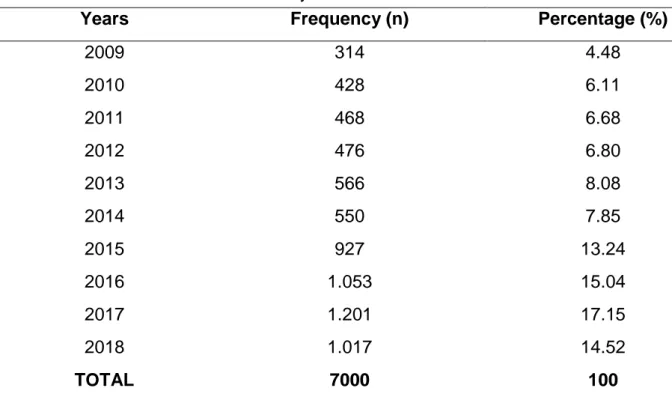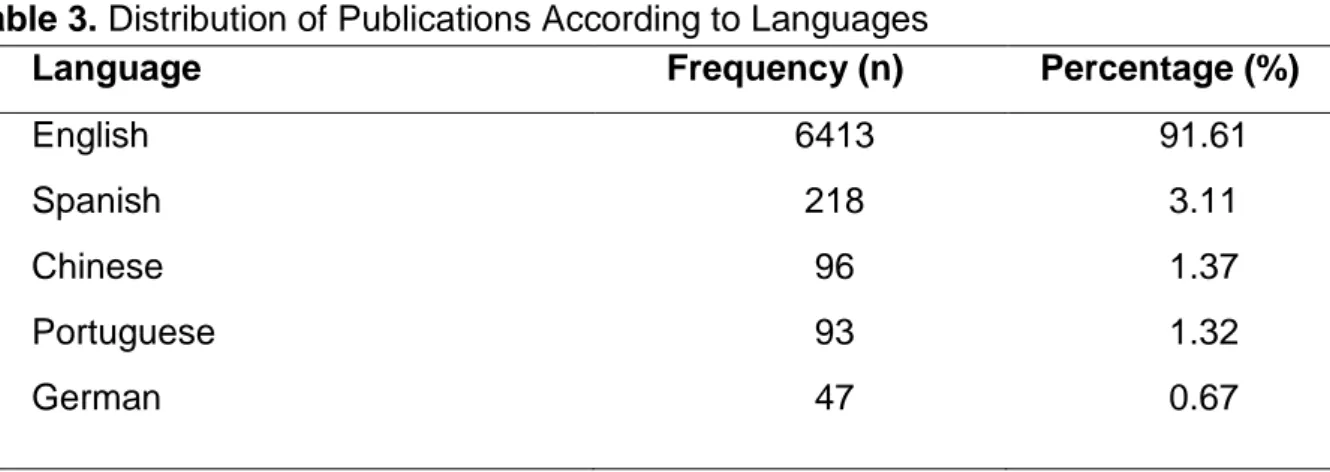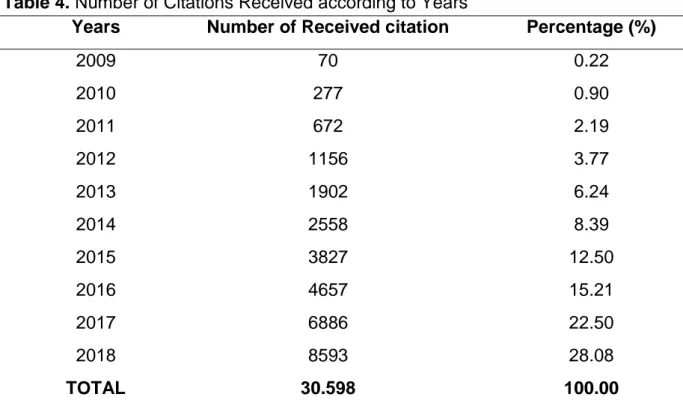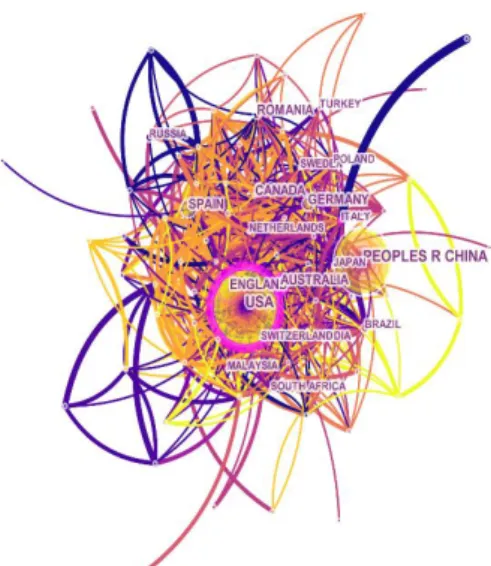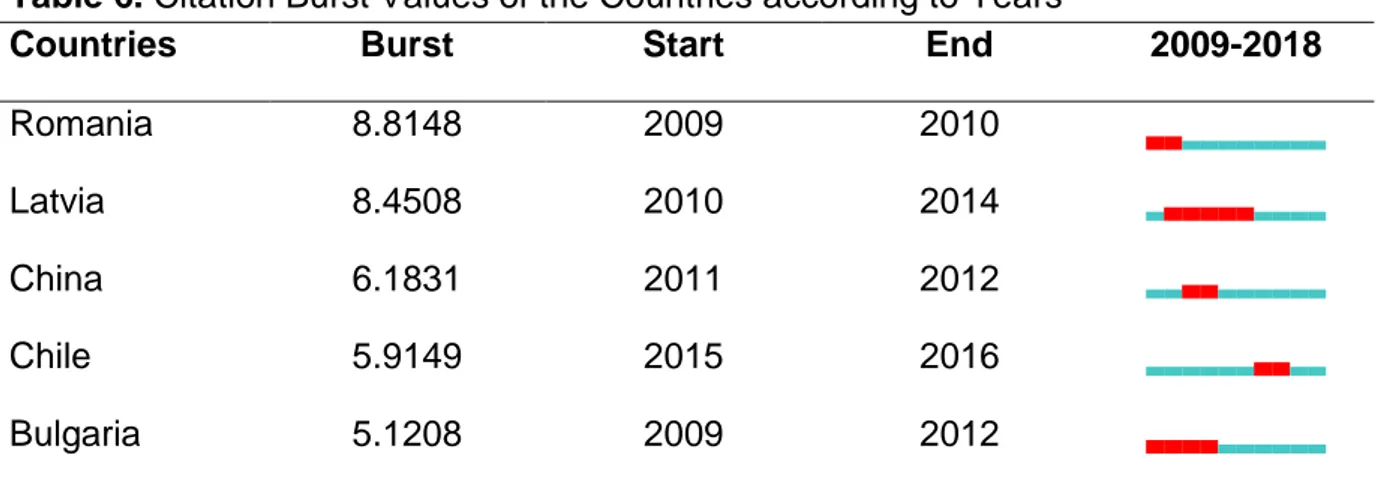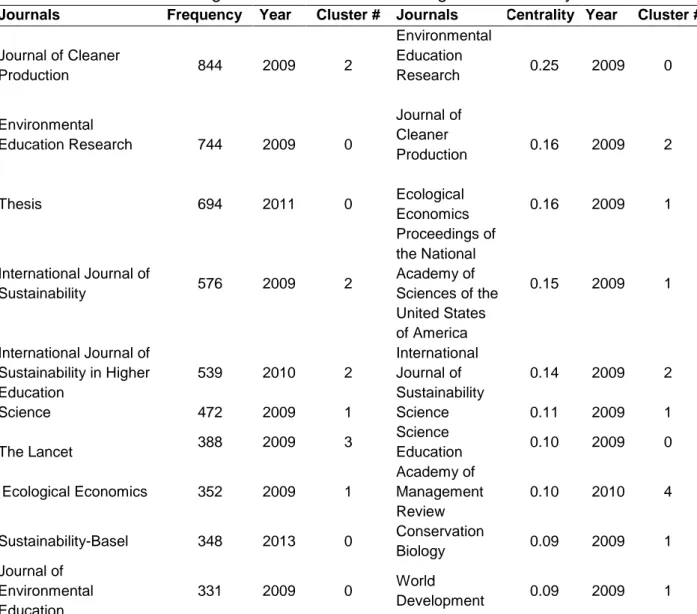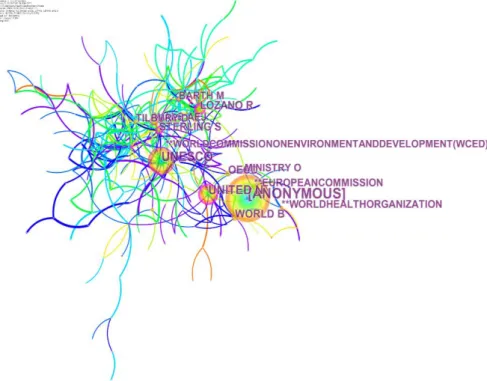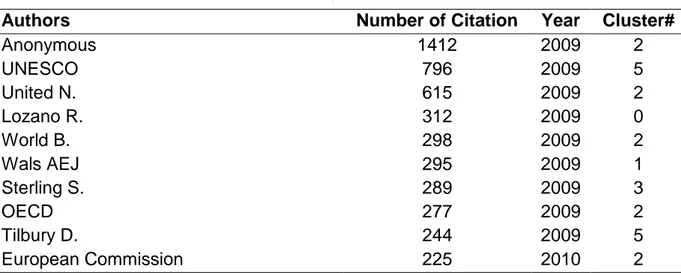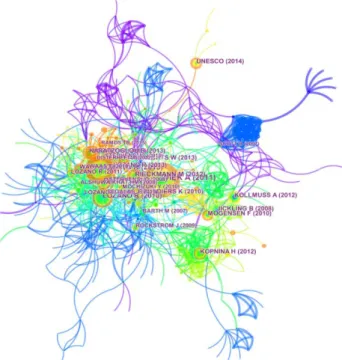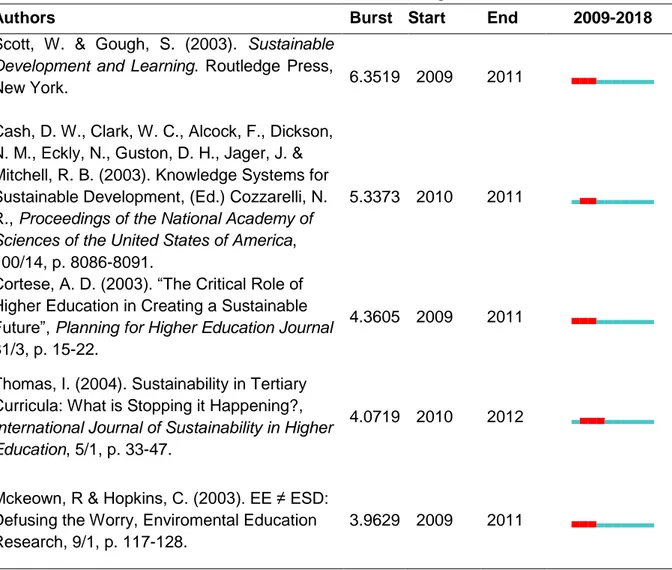ADYÜEBD Adıyaman Üniversitesi Eğitim Bilimleri Dergisi
ISSN:2149-2727
DOI: http://dx.doi.org/10.17984/adyuebd.515009
Geçmişten Günümüze Sürdürülebilir Kalkınma ve Eğitim Alanında:
Bibliyometrik Bir Analiz
Mustafa DOĞRU1*, Cem Oktay GÜZELLER2, Melahat ÇELİK3 1Akdeniz Üniversitesi, Eğitim Fakültesi, Antalya, Türkiye
2Akdeniz Üniversitesi, Turizm Fakültesi, Antalya, Türkiye 3Akdeniz Üniversitesi, Eğitim Fakültesi, Antalya, Türkiye
MAKALE BİLGİ ÖZET Makale Tarihçesi: Alındı 19.01.2019 Düzeltilmiş hali alındı 22.05.2019 Kabul edildi 17.06.2019 Çevrimiçi yayınlandı 30.06.2019 Makale Türü: Araştırma Makalesi
Çalışmanın amacı, Sürdürülebilir Kalkınma ve Eğitim alanında 2009-2018 yılları arasında yayımlanan 7000 çalışmayı bibliyometrik açıdan inceleyerek, alanda son 10 yıldaki eğilim ve trendleri ortaya koymaktır. Bu kapsamda, Web of Science Core Collection veri tabanında “Sustainable Development” ve “Education” konu başlıklarında tarama gerçekleştirilmiş ve çalışmalara ait bibliyometrik verilere ulaşılmıştır. Sürdürülebilir Kalkınma ve Eğitim ile ilgilenen akademisyen ve araştırmacılara katkı sağlamak amacıyla, sürdürülebilir kalkınma kavramıyla ilgili güncel konular, bu çalışma ile birlikte ortaya çıkarılmıştır. Çalışmalar; yıllara göre yayın sayıları, yayın türleri, yayın dilleri, atıf analizleri, ülke işbirliktelikleri, ortak atıf ağları ile kavram-konu yönelimleri bağlamında incelenmiştir. Ayrıca ortak atıf ağları ile kavram-konu yönelimlerinin belirlenmesinde sosyal ağ analizi kullanılmıştır. Analiz sonuçlarına göre, hem yayın hem de atıf sayıları bağlamında alana olan ilginin 2015 yılından sonra çarpıcı bir şekilde arttığı söylenebilir. Çalışmalar ağırlıklı olarak makale-bildiri türünde ve İngilizce dilinde gerçekleştirilmiştir. Amerika Birleşik Devletleri (ABD) ülke işbirlikteliklerinde kilit rol oynadığı, en fazla atıf sayısına sahip derginin Journal of Cleaner Production, yazarın ise Anonymous adı altındaki ismi belirlenemeyen yazarlar olduğu belirlenmiştir. Öte yandan Arnim Wiek, Lauren Withycombe ve Charles L. Redman (2011) ise alanda en çok atıf alan kaynaktır. Eğitim, sürdürülebilirlik ve Endonezya alanda en çok çalışılan konulardır.
© 2019 AUJES. Tüm hakları saklıdır Anahtar Kelimeler: Sürdürülebilir Kalkınma, Eğitim, Bibliyometri, Sosyal Ağ Analizi, Atıf
Genişletilmiş Özet Amaç
Bir bilim dalının, dünyadaki durumunu ve gelişimini görebilmek, anlayabilmek ve de bu neticede değerlendirebilmek için önemli veri tabanlarında yer alan yayınları takip etmek gerekmektedir. Herhangi bir bilim dalında yapılmış çalışmaların literatürün belli dönemlerinde incelenmesi, bu alandaki araştırmacılara yol göstermesi, o alandaki gelişmelerin seyri açısından önemlidir. Bu şekilde ortaya çıkarılacak bulgular hem o bilim dalının zaman içerisinde göstermiş olduğu gelişmeyi, baskın olan eğilimleri hem de var olan sorunları tespit
*Sorumlu Yazarın Adresi: Akdeniz Üniversitesi, Eğitim Fakültesi, Antalya. e-posta: mustafadogru@akdeniz.edu.tr
etme kolaylığı sağlayarak çözüm odaklı tartışma olanağı sağlayabilmektedir (Üsdiken & Pasedeos, 1993). Elde edilecek bulguların önemli veri tabanlarından ve akademik yayınlardan sağlanması bulguların ve sonuçların nesnelliğini sağlamaktadır. Bu doğrultuda bu çalışmanın amacı Sürdürülebilir Kalkınma ve Eğitim alanında 2009-2018 yılları arasında yayımlanan çalışmaları bibliyometrik açıdan inceleyerek alanda son 10 yıldaki eğilim ve trendleri ortaya koymaktır.
Yöntem
Sürdürülebilir Kalkınma ve Eğitim konu alanının bibliyometrik özelliklerinin belirlenmesi amacıyla yapılan bu çalışmada, araştırma probleminin çözümüne yönelik betimsel araştırma modeli kullanılmıştır. Betimsel araştırma modeli, belirli bir olay, durum veya olgunun var olan özelikleri ile açıklanmasıdır (Büyüköztürk, 2008).
Veri toplama Süreci ve Veri Analizi
Bu araştırmanın verilerini, Sürdürülebilir Kalkınma ve Eğitim alanında 2009-2018 yılları arasında yayımlanan ve Web of Science veri tabanında taranan 7000 çalışma oluşturmaktadır. Web of Science veri tabanı bilimsel yayınların atıf istatistikleri ve yayınların bibliyografik verilerine ulaşma imkânı sağlar (Meho & Yang, 2007). Web of Science Core Collection veri tabanında “ Sürdürülebilir Kalkınma” ve “Eğitim” alanlarında yayımlanan 7000 çalışmanın yayın türleri, yayın dilleri, başlıkları, yazar adları, yazarların ülkeleri, kaç kaynağa atıfta bulundukları ve Web of Science’da taranan kaç kaynaktan kendilerine atıf yapıldığı ve kaynakça bilgilerine ulaşılmıştır. Ortak atıf ağları ile kavram-konu yönelimlerinin belirlenmesinde sosyal ağ analizi olan Cite Space uygulaması kullanılmıştır. Web of Science veri tabanında 7000 çalışmaya ait veriler Cite Space programına uygun formatta yüklenerek analizler yapılmıştır. Diğer veri tabanlarının literatür taramasına dahil edilmemesinin sebebi, analizlerin gerçekleştirildiği Citespace uygulamasının, Web of Science veri tabanı ile entegre çalışan güvenilir bir yazılım olmasıdır.
Bulgular ve Tartışma
Sürdürülebilir Kalkınma ve Eğitim alanında 2009-2018 yılları arasında yayınlanan 7000 çalışmanın yıllara göre dağılımında en çok çalışmanın 2017 yılında yapılmış olduğu görülmüştür (n=1201). Çalışmalar yayın türlerine göre incelendiğinde 11 farklı türde yayın yapıldığı belirlenmiştir. Bu türler makale, bildiri, eleştiri, editoryal materyal, kitap incelemesi, kitap bölümü, toplantı özeti, düzeltme, mektup, geri çekilen yayın, biyografik öge, haberler ve yeni baskıdır. Sürdürülebilir Kalkınma ve Eğitim alanında en çok çalışma yapılan yayın türlerine bakıldığında makale ve bildiriler ağırlıkta olup, bunların toplam içerisindeki oranı % 95.34’dir.
Sürdürülebilir Kalkınma ve Eğitim alanında yapılan çalışmalara yer verilmiştir. Çalışmalar toplamda 25 farklı dilde kaleme alınmıştır. 7000 çalışmadan, %91.61’sının dili İngilizce’dir. Bunu %3.11 ile İspanyolca takip etmektedir. Çalışmalar arasında Türkçe yayın da bulunmaktadır. Bulunan Türkçe yayın sayısı 7 tane olup %0,01’ini oluşturmaktadır. Yıllara göre atıf sayıları incelendiğinde, 7000 çalışmaya en fazla atfın 2018 yılında gerçekleştirildiği gözlenmiştir (n=8593).
Çalışmadaki veriler incelendiğinde, Amerika Birleşik Devletleri (ABD) hem diğer ülkelerle en fazla işbirliği içinde yer alan ülke (n=1034) hem de en yüksek merkezilik derecesine sahip ülke olduğu ortaya çıkmıştır. Ülkelerin atıf patlama değerlerine bakıldığında, en yüksek atıf patlamasına sahip ülke 2009-2010 yılları aralığında Romanya’dır (8. 8148). Romanya 2009-2010 yılları arasını kapsayan süreçte alana yön veren çalışmaların yapıldığı ülke konumunda olduğu görülmektedir. Ayrıca Sürdürülebilir kalkınma ve eğitim alanında yayımlanan güncel çalışmalara sıklıkla atıfta bulunan ülke ise Şili olmuştur.
Sürdürülebilir Kalkınma ve Eğitim alanında yayımlanan çalışmaların en çok atıfta bulunduğu dergi Journal of Cleaner Production dergisidir (n=844). Aynı zamanda Environmental Education Research dergisi en yüksek merkezilik derecesine sahip dergi konumundadır. Çalışmamızda dergilerin yıllara göre atıf patlama değerleri gösterilmiştir. Buna göre Our Common Future dergisi, en fazla atıf patlaması değerine sahiptir (31. 6808). Sürdürülebilir kalkınma ve eğitim alanında en çok atıf yapılan 10 yazar arasından bu alanın teorik hatlarını belirleyen Anonymous adı altındaki ismi belirlenemeyen yazarlar (n=1412), UNESCO (n=796) ve UNITED NATIONS (615) ‘da ilk 3 sırada yer almaktadır. Yazarların atıf patlama değerlerine baktığımızda elde dilen veriler içerisinde en yüksek değerin 2009-2010 yılları arasında UNESCO (24.663) ‘ya ait olduğu görünmektedir.
Yayın ortak analizinde yapılan kümeleme işlemi sonucunda 291 tane küme oluşmuştur. En büyük küme 192 elemanlı UNITED NATIONS tarafından 2015 yılında gerçekleştirilen sürdürülebilir kalkınma hakkındaki genel kurul raporudur. Bu rapor önemli ilk 10 kaynak içerisinde en güncel referans kaynak olarak gösterilebilir. Sürdürülebilir kalkınma ve eğitim alanında yayımlanan çalışmalarca en çok atıfta bulunulan kaynak Arnim Wiek, Lauren Withycombe ve Charles L. Redman tarafından 2011 yılında kaleme alınan makaledir. Bu kaynak alana yön veren ve ışık tutan en önemli referans kaynaktır.
Sonuç
Sürdürülebilir Kalkınma ve Eğitim alanında 2009-2018 yılları arasında uluslararası atıf indekslerinden Web of Science veri tabanında yayımlanan çalışmaların Bibliyometrik analizine odaklanan bu çalışmanın literatüre pek çok yönden katkısı bulunmaktadır. Öncelikle çalışmamız vasıtasıyla tüm dünyada “Sürdürülebilir Kalkınma” ve “Eğitim” alanlarında önde gelen çalışmaların hangileri olduğu ortaya koyulmaktadır. Bu da
bahsettiğimiz alanlarda çalışma yapanların dünya çapındaki çalışmaları daha yakından tanımaları ve gerçekleştirecekleri çalışmalarda bunları göz önünde bulundurmaları sürecine katkı sağlayacaktır. Bunun yanında alanyazına yön veren yazarlarla birlikte, onların odaklandıkları konular ve onların çalışmalarını yayınlanan dergiler de çalışmamız vasıtasıyla okuyucuların bilgisine sunulmaktadır. Alanyazına yön veren yazarlar ve dergiler yanında söz konusu alanlarda çalışma yapılan ülkeler ve ülkeler arasındaki ortak çalışmaların durumu da çalışmamız sayesinde ortaya konulmaktadır. Ortaya konulan bu bilgiler vasıtasıyla da dünyada “Sürdürülebilir Kalkınma” ve “Eğitim” alanlarındaki genel eğilimlerin hangi yönde geliştiği tarihsel bir bütünlük içerisinde takip edilmektedir. Çalışmamız vasıtasıyla tüm dünyada güncel tartışma ve gelişmelerin odağında olan “Sürdürülebilir Kalkınma” ve “Eğitim” kavramlarının hangi ülkeler tarafından aktif olarak işlendiği ve yönlendirildiği de okuyucuların dikkatine sunulmaktadır.
AUJES Adiyaman University Journal of Educational Sciences
ISSN:2149-2727
DOI: http://dx.doi.org/10.17984/adyuebd.515009
A Bibliometric Analysis in the field of Sustainable Development and
Education from Past to Present
Mustafa DOĞRU1*, Cem Oktay GÜZELLER2, Melahat ÇELİK3 1 Akdeniz University, Faculty of Education, Antalya, Turkey
2Akdeniz University, Faculty of Tourism, Antalya, Turley
3Akdeniz University, Faculty of Education, Antalya, Turkey
AR T I C L E I N F O A B ST R A C T Article History: Received 19.01.2019 Received in revised form 22.05.2019 Accepted 17.06.2019 Available online 30.06.2019 Article Type: Research Article
The purpose of this study is to show the tendencies and trends of the last 10 years in the field of Sustainable Development and Education by analyzing 7000 studies published between 2009-2018 bibliometrically. For this purpose Web of Science Core Collection database was scanned for “Sustainable Development” and “Education” headings and the bibliometric data of the studies were acquired. Current issues concerning sustainable development were revealed through this study for the purpose of making a contribution to those academicians and researchers interested in Sustainable Development and Education. The studies were analyzed according to: number of publications per year, types of publication, language of publication, citation analysis, country collaborations, common citation networks and concept-topic tendencies. In addition, social network analysis was employed for determining common citation networks and concept-topic tendencies. According to the results of this analysis, it can be said that the interest towards the field dramatically increased after 2000, in terms of both the number of publication and citations. The studies were mainly presented in the form of article or paper and in English. It was found that United States played a key role in country collaborations, the journal with the highest number of citations is Journal of Cleaner Production, whereas the author with the highest number of citations is Anonymous under which many citations were gathered. On the other hand, the study realized by Arnim Wiek, Lauren Withycombe and Charles L. Redman in 2011 is the most important reference source that has guided the field. Education, Sustainability and Indonesia are the most studied topics in the field.
© 2019 AUJES. All rights reserved Keywords:†Bibliometrics, Citation Analysis, Education, Social Network Analysis, Sustainable Development.
Introduction
Although the impact of environmental and socio-economic problems emerged
in the 17th century (Mittler, 2001), the period where they spread very rapidity was the
20th century (Sağdıç and Şahin, 2015). Environmental problems such as: depletion of
the ozone layer, air pollution, global warming, and socio-economic problems, such
as, hunger, migration and rapid population growth, increased in the 20th Century. The
*Corresponding author’s address: Akdeniz University, Faculty of Education, Antalya. e-mail: mustafafdogru@akdeniz.edu.tr
reason of them is the human-driven damage made to the environment while conducting improvement and development activities. In this process, people tended to look for various solutions for recovering this damage and preserving the natural balance. As a result, the concept of “Sustainable Development” was created. Sustainable Development was defined as “the ability to make development sustainable to ensure that it meets the needs of the present without compromising the ability of future generations to meet their own needs” (WCED, 1987). After the creation of the concept of sustainable development, there was the need to disseminate this understanding. It was understood that the solution of this problem is education. It was emphasized that education will be the key aspect in providing sustainable development awareness and a perspective of sustainable development to the community (UNCED, 1992; WSSD, 2002). In addition, people today recognized that the progress and trend of the economy does not fit with the concept of sustainability, thus they concluded that the efforts should be directed towards rising community awareness and education (McKeown, Hopkins, Rizzi, Chrystalbride, 2002). It is assumed that in this case the ideas, values and behaviors of the community will fundamentally change in favor of sustainable development, which will be positively reflected in people’s behavior (Leiserowitz, Kates & Parris, 2006).
In the modern world, it is emphasized that the concept of Sustainable Development can be provided to the society only through education and that the necessary cognition, feeling and behavior change can be ensured in individuals by means of Sustainable Development-centered education. This worldwide general trend is also important for Turkey, as a developing country (Ozturk, 2017). The education concept of our age should aim to give individuals the main themes of “one world, coexistence and world citizenship” and this idea is constantly promoted. Therefore, sustainable development and education are inseparably integral concepts. Based on the relationship between these two concepts many concepts, including, environmental education, ecopedagogy, ecological learning, sustainability education, sustainable pedagogy, etc. have been emerged. The meaning attributed to all of these concepts is to emphasize the role of educational activities in transforming societies in order to have a sustainable future for the whole world (Öztürk, 2017).
The concept of “Education for Sustainable Development”, whose foundations date back to the 1970s, was first adopted in 1987 at the United Nations General Assembly. Under this concept, which has matured in many different practices from 1987 to the present, an important start took place with the Agenda 21 Action Plan adopted in the United Nations Conference on Environment and Development in
1992, in the 36th section under the title “Development of Education, Public
Awareness and Training”. The three subheadings adopted here clearly reveal the role of education in Sustainable Development (Kabadayı, 2015). The concept of
education for sustainable development has also come to the fore in the 4th meeting of
the United Nations Commission on Sustainable Development in 1996, where it was decided to make radical changes in education, which are necessary to promote sustainable development. In the general assembly meeting of the United Nations on
20 December 2002, the period between 2005 and 2014 was declared as “Ten Years of Education for Sustainable Development”. Thus, it has been decided to develop many new policies and practices related to the contribution of education to the
sustainable development process. This process ended with the “UNESCO World
Conference on Education for Sustainable Development” held in Japan in 2014. In the conference, it was seen that, in many world countries social, environmental and economic dimensions of education were more considered compared to the past, the modifications were made in education systems in accordance with the decision taken. It was revealed that more and more countries have set new strategies for sustainable development (Kabadayi, 2015).
Regarding the institutions that give direction to the trends that have started in the field of sustainable development, the Foundation for Environmental Education (FEE) can be mentioned first. The Foundation carries out activities for the implementation and development of the projects in the field of education for sustainable development, across Europe and South Africa. Thanks to their projects, the Agenda 21 Action Plan adopted by the United Nations gains functioning. The Eco-Schools Project is another example of activity in the field of education for Sustainable Development. This project, which aims to provide environmental awareness, environmental management and sustainable development education in schools, includes schools from all over the world. In our country, Environmental Education Foundation is engaged in the coordination of the Eco-Schools Project. Despite all the efforts mentioned above, the desired status has not been reached yet. In order to achieve the desired level of education for sustainable development, this issue needs to become a state policy (Yapıcı, 2003). In order to establish the concept of sustainable development in society, the awareness of society on this issue should be developed first. Education is one of the most important tools in the creation and development of this awareness. However, there are some problems that education is facing regarding sustainable development. One of them is that the response of the
people to environmental problems didn’t improved since the 17th century because of
their ignorance about their personal responsibility. This also means that no lessons have been learned from the past. For this reason, education for sustainable development should be given by providing values for the future. In addition, providing personal perceptions besides developing global perceptions should be targeted as well (Teksöz, 2014).
The most significant way of integrating sustainable development philosophy into education is through imparting this philosophy to educational institutions and to ensure that it is covered in their curriculums. Thus, concerns about the common future of the world can be shared and the collective consciousness required for producing and executing solutions can be generated in new generations. The economic competition of today’s world and the huge budget allocated for armaments are giving serious damage to the philosophy of sustainable development. The way of preventing it, is equipping all systems related to education with a common sprit and philosophy and motivating them. The only negative aspect of it, is that it takes time to see the outcomes of the investments made in education. However, the investments
made on education should be seen as an effort worth trying for the common future of the world (Yapıcı, 2003).
It is obvious that education is alone insufficient for the establishment of sustainable development and a sustainable future, but this is the main difficulty encountered while establishing a sustainable world. The educators in all nations of the world should make contribution to this process, in this way it may be possible to end seeing a sustainable world as a dream (Unesco, 2005). In this process, the community should take responsibility in addition to the contribution and responsibilities of the educators. McKeown et al. (2002), emphasized that all disciplines could not focus solely on education for sustainable development and that they should not.
In order to visualize, understand and correctly evaluate the status and development of a discipline in the world, publications in the important databases should be followed. Analyzing the studies made in a discipline during a certain period of the literature is important in terms of guiding the researchers, and establishing the course of the progress in this field. The findings that will be revealed in this way will allow us to determine the progress of the discipline over time, dominant trends and existing problems, thus it may provide the opportunity for solution-oriented debates (Üsdiken and Pasedeos, 1993). Obtaining the data for this research from important databases and academic publications ensure the objectivity of the findings and results.
In order to reveal the patterns, intellectual characteristics and up-to-dateness of the researches conducted in a scientific area, the studies that have mostly affected the researches on this area and accordingly the most studied sub-fields and the most cited authors in the field should be analyzed (Åström, 2007; White, 2003; Shiffrin and Börner, 2004; Small, 1973; Zhao and Strotmann, 2008). There is no such study revealing intellectual characteristics of the field of Sustainable Development and
Education, either domestically, or internationally. However, bibliometric
characteristics of all publications published in the citation directory of a particular field or discipline were examined. In these researches many attributes were analyzed, including type of publication, language of publication, the country with most publication, the authors with most publications, and the most cited sources. Many researchers have bibliometrically analyzed the studies published in SCI (Science
Citation Index): for example, Gökçeoğlu and Sezer (2009) concerning landslides;
Uzun (2002) concerning renewable energy outputs of twenty-five big nations and Konur (2011) concerning moss and bioenergy. Scientific progress is the most important factor for the economic and cultural development of society. Therefore, an objective evaluation of the researchers, educational institutions and research activities of the countries will help to understand the current state of the scientific structure in a given area and its possible future development (Matcharashvili et al., 2014, 346). Bibliometric analysis is an analysis technique used to reveal the current state of a particular discipline, field or subject and to predict future trends. Bibliometric methods provide quantitative analysis of written publications. The use of bibliometric methods stems from the need of assessing scientific production clearly
and presenting the obtained results in a way allowing policy-makers, scientists or other stakeholders to benefit from them (Ellegaard, 2015, 1810-1812). In our study, scientific researches on sustainable development and education will be examined using bibliometric techniques. Thus, prominent writers, countries, studies in this field and the concepts that emerged in the context of these studies will be identified and inferences will be made about their future trends.
Purpose of the Research and Sub-Problems
The purpose of this study is to determine the tendencies and trends in the last 10 years through the bibliometric analysis of 7000 studies published in the field of Sustainable Development and Education, between 2009 and 2018. Determining the bibliographic characteristics of 7000 studies published in the field of Sustainable Development and Education in 2009-2018 and scanned in the Web of Science database constitutes the problem of the study. In this context, the following sub-problems determined within the scope of the research were addressed:
Regarding scientific studies performed in the field of sustainable development and education:
1- What is the distribution according to the number of publications on an annual
basis?
2- What is the distribution according to the type of publication? 3- What is the distribution according to the language of publication? 4- What is the distribution according to the number of citations?
5- What is the distribution according country collaborations and productivity? Regarding Sustainable Development and Education;
6- What are the journals guiding the field? 7- Who are the researchers guiding the field 8- What are the researches guiding the field?
9- What are the emerging trendy topics and how they are shaped? Methodology
In this study, which aims to determine the bibliometric properties of Sustainable Development and Education subject area, the descriptive research model was used to address the research problem. Descriptive research model is the explanation of a particular event, situation or phenomenon with the existing features (Büyüköztürk, 2008).
Data Collection Process
In the study, the data on Sustainable Development and Education were obtained from the Web of Science database, which provides access to the citation statistics of scientific publications and the bibliographic data of the publications (Meho and Yang, 2007). In the Web of Science database, “sustainable development
and education” was used as the term to search. In the literature, bibliometric studies have an approach that periodically examines the scientific studies at specific time intervals (Palmer et al., 2005; Wei & Zhao, 2015). This allows researchers to examine current trends in a particular area for research design (such as the last decade) or periodically make temporal comparisons. Since the study was designed to reveal current developments and trends in the last decade (2009-2018), in the field of sustainable development and education, it has been restricted in terms of time. As a result of the review, 7000 studies have been accessed. The reason of excluding other databases in the literature review is that the Citespace application, by which the analyzes were performed, is a reliable software that is integrated with the Web of Science database.
The types of publication, languages of publication, titles, name of the authors, country of the authors, number of sources cited in the study, number of sources (scanned in Web of Science) that cited the study as a source and references data of
7000 studies contained in the fields of “Sustainable Development” and “Education”
were reached through Web of Science Core Collection database. The reason of including all types of publications in the analysis is that each type of publication adds a separate scientific quality and richness to the topic of sustainable development and education. For example, the book chapters provide a summary of the content of a basic work written in the field, whereas proceedings are useful sources for identifying current scientific discussions and foci in the field, etc.
Data Analysis
Cite Space application, which is a social network analyzer, was used to determine common citation networks and concept-topic tendencies. The data of 7000 studies obtained from Web of Science database was uploaded to Cite Space software in the appropriate format. Cite Space is a Java application to visualize and analyze the emerging trends and the changes on scientific literature (Chen, Ibekwe-San Juan & Hou, 2010.
As a result of the analysis conducted, several characteristics of the created network were calculated, including network density, modularity and mean silhouette (Q) values of the network. The figure showing the amount of connection in a network is network density (Al and Doğan, 2012). The concept indicating the strength of division of a network into modules is modularity value, which varies between 0-1 and has particular meaning according to its magnitude. A high modularity value shows a well-structured network, whereas low modularity value indicates an ill-structured network that cannot be reduced into modules with clear boundaries (Chen et al., 2010). Modularity value being equal or higher than 0.6 means that the division is meaningful (Newman, 2004). On the other hand, mean silhouette value varies between -1 and 1 (Chen et al., 2010). This value, which indicates the number of clusters, should be higher than 0.7 in order to show a strong clustering (Simovici, 2007).
The positions of country collaborations, cited journals and publications, and concepts in the network were determined according to their betweenness centrality
value, which indicates the degree of the connection between a node and other nodes that are not connected to each other (Ni, Sugimoto, Robbin, 2017). Another important finding of the study is citation bursts, which indicate statistically significant fluctuations of a frequency over the total time period (Chen et al., 2010).
Findings
Findings of the First Sub-Problem Number of Publications According to Years
Regarding the distribution of the 7000 studies in the Sustainable Development and Education field between 2009-2018 according to years displayed in Table 1, it is seen that the highest number of studies was performed in 2017 (n=1201). The number of published studies generally increased in each time period.
Table 1. Distribution of Publications by Years
Years Frequency (n) Percentage (%)
2009 314 4.48 2010 428 6.11 2011 468 6.68 2012 476 6.80 2013 566 8.08 2014 550 7.85 2015 927 13.24 2016 1.053 15.04 2017 1.201 17.15 2018 1.017 14.52 TOTAL 7000 100
Findings of the Second Sub-Problem Types of Publication
Table 2 shows the studies according to publication type; it was found that 11 different types of publication were made, which are article, paper, critics, editorial material, book review, book section, meeting summary, correction, letter, retreated publication, biographical items, news, and new edition. The top 6 types of publication made in the field of Sustainable Development and Education are displayed in Table 2. Since some studies are included in more than one category, the percentages were calculated over 7089 publications. The ratios of the publication in the form of the article and paper are quite high; their percentage in overall is 95.34 %.
Findings of the Third Sub-Problem Language of publication
Table 3 shows the studies made in Sustainable Development and Education field according to the publication language. The studies were written in 21 different languages. The top 5 publication languages are shown in the table. 91.61% of 7000 studies are in English, followed by Spanish with 3.11%. There are some studies in Turkish as well; but the number of publications in Turkish is only 7, which constitutes 0.01% of the publications.
Table 2. Distribution of Publications According to Type
Type of Publication Frequency (n) Percentage (%)
Article 4055 57.92 Paper 2620 37.42 Critics 251 3.58 Editorial Material 109 1.55 Book Review 27 0.38 Book Section 10 0.14
Table 3. Distribution of Publications According to Languages
Language Frequency (n) Percentage (%)
English 6413 91.61
Spanish 218 3.11
Chinese 96 1.37
Portuguese 93 1.32
Findings of the Forth Sub-Problem Citation Analysis
A total of 30,829 sources were cited by 7000 studies published in the field of Sustainable Development and Education in 2009-2018.
Table 4. Number of Citations Received according to Years
Years Number of Received citation Percentage (%)
2009 70 0.22 2010 277 0.90 2011 672 2.19 2012 1156 3.77 2013 1902 6.24 2014 2558 8.39 2015 3827 12.50 2016 4657 15.21 2017 6886 22.50 2018 8593 28.08 TOTAL 30.598 100.00
Regarding the number of citations received according to years displayed in Table 4, it was observed that the maximum number of citations made to 7000 studies have been realized in 2018 (n=8593). The citations received in the determined time periods constantly increased over the years.
Findings of the Fifth Sub-Problem Country Collaborations
Social network analysis was performed to determine the researches that researchers from different countries have performed together. The countries were scaled according to the degree of centrality and showed in Figure 1.
Figure 1. Country Collaborations
N=83 E=0 Density= 0 Modularity Q= 0.21 Mean Silhouette= 0.25 Number of Cluster= 7
As a result of this analysis, a network consisting of 83 nodes was obtained. The network is divided into 7 clusters. While analyzing country collaborations, a country was counted once for the publications containing two or more authors from the same country. Each node of the network represents a country, whereas each connection represents the relationship between countries. The lines between nodes get thicker as the number of connections increases. The modularity value of the network was found to be Q= 0.21, whereas mean silhouette value is 0.25. The network values of top 10 countries, which have a significant place in the network, are given in detail, in the table below.
Findings of the Sixth Sub-Problem Table 5. Country Collaborations and Degree of Centrality
Countries Frequency Year Cluster# Countries Frequency Year Cluster#
USA 1034 2009 2 USA 0.23 2009 2 Chinese 947 2009 2 England 0.12 2009 1 England 573 2009 1 Australia 0.12 2009 2 Australia 397 2009 2 Italy 0.10 2009 3 Spain 354 2009 1 Netherland 0.09 2009 1 Germany 352 2009 1 Canada 0.08 2009 1 Romania 317 2009 3 Scotland 0.07 2009 0 Canada 247 2009 1 Spain 0.06 2009 1 Brazil 231 2009 2 Swiss 0.06 2009 0 Sweden 221 2009 1 Belgium 0.06 2009 1
According to the data presented in Table 5, USA seems to be the country making the most collaborations with other countries (n=1034). Moreover, USA is the country with the highest centrality.
Table 6. Citation Burst Values of the Countries according to Years
Countries Burst Start End 2009-2018
Romania 8.8148 2009 2010 ▃▃▂▂▂▂▂▂▂▂
Latvia 8.4508 2010 2014 ▂▃▃▃▃▃▂▂▂▂
China 6.1831 2011 2012 ▂▂▃▃▂▂▂▂▂▂
Chile 5.9149 2015 2016 ▂▂▂▂▂▂▃▃▂▂
Bulgaria 5.1208 2009 2012 ▃▃▃▃▂▂▂▂▂▂
Regarding citation burst values of the countries according to years in Table 6, the country with the highest citation burst is Romania, in 2009-2010 (8.8148). Again, Romania is seen to be the country that guided the field in 2009-2010. In addition, Chile is the country that was frequently cited in the recent studies published in the area of Sustainable Development and Education.
Journal’s Common Citation Network
The common citation network analysis of the journals aims to determine the journals, in which the significant scientific studies that were cited by other studies have been published in the field of Sustainable Development and Education.
Journal’s Common Citation network in Figure 2 consists of 140 nodes (journals that are source of the citations), its modularity value is Q= 0. 51, whereas mean silhouette value is 0.35. Citation bursts are displayed in Table 8.
Table 7. Journals Receiving Common Citations and Degree of Centrality
Journals Frequency Year Cluster # Journals Centrality Year Cluster #
Journal of Cleaner Production 844 2009 2 Environmental Education Research 0.25 2009 0 Environmental Education Research 744 2009 0 Journal of Cleaner Production 0.16 2009 2 Thesis 694 2011 0 Ecological Economics 0.16 2009 1 International Journal of Sustainability 576 2009 2 Proceedings of the National Academy of Sciences of the United States of America 0.15 2009 1 International Journal of Sustainability in Higher Education 539 2010 2 International Journal of Sustainability 0.14 2009 2 Science 472 2009 1 Science 0.11 2009 1 The Lancet 388 2009 3 Science Education 0.10 2009 0 Ecological Economics 352 2009 1 Academy of Management Review 0.10 2010 4 Sustainability-Basel 348 2013 0 Conservation Biology 0.09 2009 1 Journal of Environmental Education 331 2009 0 World Development 0.09 2009 1
As can be seen from Table 7, the journal that has been cited the most by the studies published in the field of Sustainable Development and Education is Journal of Cleaner Production (n=844), but Environmental Education Research is the journal with the highest degree of centrality.
Table 8. Citation Burst Values of the Journals according to Years
Journals Burst Start End 2009-2018
Our Common Future 31.6808 1990 2012 ▃▃▃▃▂▂▂▂▂▂
Science Education 22.7705 2009 2015 ▃▃▃▃▃▃▃▂▂▂
Journal of Engineering Education 20.3134 2013 2014 ▃▃▃▃▃▃▂▂▂▂
Education Research 19.3053 2013 2014 ▂▂▃▃▃▃▂▂▂▂
International Journal of Engineering Education 14.2882 2008 2012 ▃▃▃▃▂▂▂▂▂▂
The citation burst values of the journals according to years are shown in Table 8. Our Common Future journal has the highest citation burst value (31.6808). On the other hand, Science Education (2009-2015) journal is among the journals cited by the most recent researches in the field.
Findings of the Seventh Sub-Problem Author’s Common Citation Network
Figure 3. Author’s Common Citation Network
Author’s common citation network shown in Figure 3 consists of 222 nodes (authors that are source of the citations) and 377 clusters. Its modularity value is Q= 0. 46, and mean silhouette value is 0.16.
Table 9. Number of Citation for Commonly Cited Authors
Table 9 shows top 10 authors that get common citations. It can be seen from Table 9 that regarding the mostly cited authors in Sustainable Development and Education area, the ones that determine the theoretical shapes of this area are unnamed authors gathered under title Anonymous (n=1412), followed by UNESCO (n=796) and UNITED NATIONS (615). Both Lozano R. (n=312) and World B (n=298), who contributed on the development of the field, come after them.
Table 10. Citation Burst Values of the Authors According to Years
Authors Burst Start End 2009-2018
UNESCO 24.663 2009 2010 ▃▃▂▂▂▂▂▂▂▂ Scot W. 14.7298 2009 2013 ▃▃▃▃▃▂▂▂▂▂ World B. 14.6627 2009 2011 ▃▃▃▂▂▂▂▂▂▂ Fien J. 12.4364 2009 2013 ▃▃▃▃▃▂▂▂▂▂ UN 11.3953 2009 2011 ▃▃▃▂▂▂▂▂▂▂ WHO 10.8513 2009 2011 ▃▃▃▂▂▂▂▂▂▂ Gough S. 9.8534 2009 2012 ▃▃▃▃▂▂▂▂▂▂ Fullan M. 8.1492 2009 2012 ▃▃▃▃▂▂▂▂▂▂ Senge P.M. 8.1492 2009 2012 ▃▃▃▃▂▂▂▂▂▂ Jensen B. 7.776 2010 2012 ▂▃▃▃▂▂▂▂▂▂
According to citation burst values of the authors in Table 10, it can be seen that the highest value in 2009-2010 belongs to UNESCO (24.663). It can be said that the studies of UNESCO have leaded the researches made in the 1-year period. In terms of topicality, it can be said that the researches of Fien J. (2009-2013) and Scott W. (2009-2013) attract attention in the recent years.
Regarding the results of citation burst values, it can be seen that there are only 4 authors common in mostly cited authors and popular authors, which are UNESCO, UNITED NATIONS, World B. and WHO.
Authors Number of Citation Year Cluster#
Anonymous 1412 2009 2 UNESCO 796 2009 5 United N. 615 2009 2 Lozano R. 312 2009 0 World B. 298 2009 2 Wals AEJ 295 2009 1 Sterling S. 289 2009 3 OECD 277 2009 2 Tilbury D. 244 2009 5 European Commission 225 2010 2
Findings of the Eighth Sub-Problem Publication’s Common Citation Network
Figure 4. Publication’s Common Citation Network
Publication common citation network analysis include the publications mentioned in the references. As a result of the analysis 825 publications have been covered in the analysis. The map formed by this analysis is shown in Figure 4, its modularity value is 0.78 and mean silhouette value is 0.15.
Table 11. Number of citations taken by Citation Sources Sources
Number of Citations
Year Cluster# Wiek, A., Withycombe, L. & Redman, C. L. (2011).
Key Competencies in Sustainability: A Reference Framework for Academic Program Development. Sustain Sci 6, p. 203-218.
126 2011 0
Lozano, R., Lukman, R., Lozano, F. J., Huisingh, D. & Lambrechts, W. (2013). Declarations for Sustainability in Higher Education: Becoming Better Leaders, Through Addressing the University System. Journal of Cleaner Production, 48, p. 10-19.
103 2013 1
United Nations, (2015). Transforming our World: the
Nations Sustainable Development Summit 2015 (Resolutions and decisions A/RES/70/1, p. 1-35.
Lozano, R. (2010). Diffusion of Sustainable
Development in Universities’ Curricula: An Empirical Example from Cardiff University. Journal of Cleaner Production, 18, p. 637-644.
75 2010 1
Barth, M. & Rieckmann, M. (2012). Academic Staff Development as a Catalyst for Curriculum Change Towards Education for Sustainable Development: An Output Perspective. Journal of Cleaner Production, 26, p. 28-36.
57 2012 0
Lozano, R., Ceulemans, K., Alanso-Almeida, M., Huisingh, D, Lozano, F. J., Waas, T., Lambrechts, W., Lukman, R. & Huge, J. (2015). A Review of Commitment and Implementation of Sustainable Development in Higher Education: Results from a Worldwide Survey. Journal of Cleaner Production, 108, p. 1-18.
55 2012 1
Jickling, B. & Wals, A. E. J. (2008). Globalization and
Environmental Education: Looking Beyond
Sustainable Development. Journal of Curriculum Studies, 40, p. 1-21.
54 2015 1
Karatzoglou, B. (2013). An in-depth Literature Review of the Evolving Roles and Contributions of Universities to Education for Sustainable Development. Journal of Curriculum Studies, 49, p. 44-53.
52 2008 5
Kollmuss, A, & Agyeman, J. (2002). Mind the Gap: Why do People Act Environmentally and What Are the
Barriers to Pro-environmental Behavior?.
Environmental Education Research, 8/3, p. 239-260.
51 2013 1
Barth, M. & Rieckmann, M. (2012). Academic Staff Development as a Catalyst for Curriculum Change Towards Education for Sustainable Development: An Output Perspective. Journal of Cleaner Production, 26, p. 28-36.
Table 11 shows the number of citations taken by citation sources. As a result of the clustering made in common publication analysis, 291 cluster were formed. The biggest cluster has 192 elements and it is the general assembly reports realized by UNITED NATIONS, in 2015. This report can be seen as the most recent reference source among the top 10 significant sources. The source that has been cited the most by the studies published in Sustainable Development and Education area is the article included in Cluster#0, written by Arnim Wiek, Lauren Withycombe and Charles L. Redman, in 2011.
Table 12. Citation Burst Values of the Sources according to Years
Authors Burst Start End 2009-2018
Scott, W. & Gough, S. (2003). Sustainable Development and Learning. Routledge Press,
New York. 6.3519 2009 2011 ▃▃▃▂▂▂▂▂▂▂
Cash, D. W., Clark, W. C., Alcock, F., Dickson, N. M., Eckly, N., Guston, D. H., Jager, J. & Mitchell, R. B. (2003). Knowledge Systems for Sustainable Development, (Ed.) Cozzarelli, N. R., Proceedings of the National Academy of Sciences of the United States of America, 100/14, p. 8086-8091.
5.3373 2010 2011 ▂▃▃▂▂▂▂▂▂▂
Cortese, A. D. (2003). “The Critical Role of Higher Education in Creating a Sustainable Future”, Planning for Higher Education Journal 31/3, p. 15-22.
4.3605 2009 2011 ▃▃▃▂▂▂▂▂▂▂
Thomas, I. (2004). Sustainability in Tertiary Curricula: What is Stopping it Happening?, International Journal of Sustainability in Higher Education, 5/1, p. 33-47.
4.0719 2010 2012 ▂▃▃▃▂▂▂▂▂▂
Mckeown, R & Hopkins, C. (2003). EE ≠ ESD: Defusing the Worry, Enviromental Education Research, 9/1, p. 117-128.
3.9629 2009 2011 ▃▃▃▂▂▂▂▂▂▂
Table 12 includes top five sources with the highest citation burst. The frequency of the citations made to the sources may vary because in some periods particular studies received intense citations on the basis of the examined subject. Regarding the periods of the sources aroused as a result of the citation bursts in Table 12, “Scott, W. & Gough, S. (2003), Sustainable Development and Learning. Routledge Press, New York” is the publication that has drawn interest for the longest time in the literature.
Findings of the Ninth Sub-Problem Sustainable Development and Education Topic Clusters
The publication’s common citations network is also used to identify the trend of the topics in a field. Numerous citations made to a particular source in a certain area, by different studies is an indicator that these studies are working on similar-related topics (Ukşul, 2016).
Table 14. Topic Clusters Formed according to Citation Sources Cluster Size Mean
Silhouette Label (TFIDF) Label (LLR) p-value Average Citation Year 0 38 0.503 Education Sustainability Education (1077,54,
1.0E-4)
2011 1 38 0.462 Education Young People (1272,6, 1.0E-4) 2011 2 36 0.483 Education Haor Livelihood (2128,27, 1.0E-4) 2010 3 19 0.682 Sustainability Ng e-course (1294,6, 1.0E-4) 2010 4 19 0.674 Education Science Teachers Selection
(1308,79, 1,0E-4)
2010 5 2 1 Indonesia Rural Development (71,97, 1.0E-4) 2009
As can be seen from Table 13, it can be said that the largest cluster is Cluster #0, including the studies related to Education (n=38). The silhouette value of the cluster is 0.503. The most recent research topics in the field is Education.
Discussion
Regarding the distribution of 7000 studies published between 2009-2018 in the field of Sustainable Development and Education, it is seen that the highest number of studies was conducted in 2017 (n = 1201). The review of the studies according to the publication types showed 11 different types of publications, which are article, paper, critics, editorial material, book review, book section, meeting summary, correction, letter, retreated publication, biographical items, news, and new edition. Regarding mostly performed publication types in the field of Sustainable Development and Education, articles and papers constitutes the majority, with a percentage of 95.34% in overall.
The studies were written in 25 different languages. 91.61% of 7000 studies are in English, followed by Spanish with 3.11%. There are some studies in Turkish as well; but the number of publications in Turkish is only 7, which constitutes 0.01% of the publications. Regarding the number of citations according to years, it was observed that the maximum number of citations made to 7000 studies have been realized in 2018 (n=8593).
According to the data of the study, USA was found to be the country making the most collaborations with other countries (n=1034), and the country with the highest centrality degree. Regarding citation burst values of the countries, the
country with the highest citation burst is Romania in 2009-2010 (8.8148). Romania appears to be the country where the studies that guided the field in 2009-2010 have been performed. In addition, Chile is the country that was frequently cited in the recent studies published in the area of Sustainable Development and Education.
The journal that has been cited the most by the studies published in the field of Sustainable Development and Education is Journal of Cleaner Production (n=844). At the same time, Environmental Education Research is the journal having the highest degree of centrality. The citation burst values of the journals according to years are shown in our study. Accordingly, Our Common Future journal has the highest citation burst value (31.6808). Regarding the mostly cited authors in Sustainable Development and Education area, the top three that determine the theoretical shapes of this area are unnamed authors gathered under title Anonymous (n=1412), followed by UNESCO (n=796) and UNITED NATIONS (615). Regarding citation burst values of the authors, it can be seen that the highest value in 2009-2010 belongs to UNESCO (24.663).
As a result of the clustering made in common publication analysis, 291 cluster were formed. The biggest cluster has 192 elements and it is the general assembly reports realized by UNITED NATIONS, in 2015. This report can be pointed as the most recent reference source among the top 10 significant sources. The source that has been cited the most by the studies published in Sustainable Development and Education area is the article written by Arnim Wiek, Lauren Withycombe and Charles L. Redman, in 2011. This is the most important reference source that guided and brought light to the area.
Conclusion and Suggestions
The concept of sustainable development and addressing it through education, allocating more place for it in education programs, is a subject on which researchers, who are academically interested in this topic and who examine this topic, have worked extensively. Sustainable Development and Education is an area of academic interest. Thus, it is important to reveal the general situation of this subject.
This study, which focuses on the bibliometric analysis of studies published in the Web of Science database of international citation indexes between 2009-2018 in the field of Sustainable Development and Education, contributes to the literature in
many ways. First of all, the most important works in the fields of “Sustainable
Development” and “Education” all around the world were revealed, which will contribute to those who study in the mentioned areas to know better the studies conducted around the world and to take them into account. In addition to this, the authors who guide the literature, the topics they focus on and the journals that publish their works are presented to the readers through our study. Along with the authors and journals that guided the literature, the countries working in the mentioned fields and the status of the joint studies between the countries were also revealed by our study. With this information, the direction of general trends in the
fields of “Sustainable Development and Education” in the world can be followed with a historical integrity. The countries actively processing and guiding the concepts of “Sustainable Development and Education”, which are the focus of current discussions and developments all over the world, were also brought into the attention of the readers.
This bibliometric analysis method performed in the field of Sustainable Development and Education can also be applied to different subject areas. The data of the research topic can be obtained through Web of Science database and the number of publications by years, publication types, publication languages, citation analyzes, country collaborations, common citation networks and concept-topic tendencies can be determined. Globally prevalent tendencies and current trends can be determined through the bibliometric study performed here and similar ones, which may provide new studies with the opportunity of following successful publications, and processing current topics. It is quite obvious that nowadays, the issue of being aware of the current situation is a necessity in all areas. In addition to identifying successful publications, this type of work will also increase the request for accessing these publications. In this way, this research should also increase the quality of the research process.
Bibliometric analysis of international journals that are pioneers in Sustainable Development and Education can be performed. With the help of this analysis, the articles published in the popular journal of the field in certain years and scanned in the Web of Science database can be accessed and the bibliometric characteristics of these articles can be determined. For example the following can be identified: the distribution of the publications in a certain journal according to years, types, languages, authors, institutions and countries; the presence of common characteristics; the distribution of the authors by titles; the distribution of the citations taken by the publications and authors; literature aging of the journal; the distribution of the sources cited in the publications by being domestic and foreign and according to their age; the pattern formed by the journals and authors cited in the publications; and topic trends in the publications and the position of the journal in Citation Reports
The increase in the number of international studies in the field of Sustainable Development and Education in Turkey is expected to carry our country one step ahead in the world literature.
References
Al, U. ve Doğan, G. (2012). “Hacettepe Üniversitesi bilgi ve belge yönetimi bölümü tezlerinin atıf analizi”, Türk Kütüphaneciliği, 26(2):349-369.
Åström, F. (2007). “Changes in the LIS research front: Time-sliced cocitation analysis of LIS journal articles, 1990-2004”. Journal of the American Society for Information Science and Technology, 58, 947-957.
Büyüköztürk, Ş., Kılıç Çakmak, E., Akgün, Ö.E., Karadeniz, Ş. ve Demirel, F. (2008), Bilimsel araştırma yöntemleri, Pegem Yayınları, Ankara.
Chen, C., Ibekwe‐San Juan, F. and Hou, J. (2010). “The Structure and Dynamics of Cocitation Clusters: A Multiple‐perspective Cocitation Analysis”, Journal of the American Society for Information Science and Technology, 61(7), 1386-1409.
Ellegaard, O., & Wallin, J. A. (2015). The Bibliometric Analysis Of Scholarly Production: How great is the impact?. Scientometrics, 105(3), 1809-1831.
Gökçeoğlu, C. ve Sezer, E. (2009). “A statistical Assessment on International Landslide Literature (1945-2008)”. Landslides, 6 (4), 345-351.
Kabadayı, R. (2015). “Sürdürülebilir Kalkınma ve Eğitim”. Prof. Dr. İbrahim Ethem Başaran’a Armağan. (Eds). İ. Aydın & Ş. Çınkır. Ankara, Anı Yayıncılık, 165-179.
Konur, O. (2011). “The Scientometric Evaluation of the Research on the Algae and Bioenergy”. Applied Energy, 88 (10), 3532-3540.
Leiserowitz, A. A., Kates, R. W. and Parris, T. M. (2006). “Sustainability
Values, Attitudes and Behaviors: A Review of Multinational and Global Trends”. Annual Review of Environment and Resources, 31, 413-444.
Li, W., & Zhao, Y. (2015). Bibliometric Analysis of Global Environmental Assessment Research in A 20-Year Period. Environmental Impact Assessment Review, 50, 158-166.
Matcharashvili, T., Tsveraidze, Z., Sborshchikovi, A., & Matcharashvili, T.
(2014). “The Importance Of Bibliometric Indicators For The Analysis Of Research
Performance In Georgia”. Trames: A Journal of the Humanities & Social Sciences, 18(4).
McKeown, R., Hopkins, C., Rizzi, R., Chrystalbride, M. (2002). Education for Sustainable Development Toolkit Version 2. Knoxville: Waste Management Research and Education Institution.
Meho, L. I. ve Yang, K. (2007). “Impact of Data Sources on Citation Counts and Rankings of LIS Faculty: Web of Science versus Scopus and Google Scholar”. Journal of the American Society for information Science and Technology, 58(13), 2105-2125.
Mittler, D. (2001). “Hijacking sustainability? Planners and the Promise and Failure of Local Agenda 21”. Eds. A. Layard, S. Davoudi ve S. Batty, Planning for Sustainable Future. New York: Spon Press, 53-60.
Newman, M. E. (2004). “Fast algorithm for detecting community structure in networks”, Physical Review E, 69(6):1-5.
Ni, C., Sugimoto, C. R. and Robbin, A. (2017). “Examining the Evolution of the Field of Public Administration through a Bibliometric Analysis of Public Administration Review”, Public Administration Review, 77(4):496-509.
Öztürk, M. (2017). “Sürdürülebilir Gelişme Odaklı Eğitim: Kuramsal Çerçeve, Tarihsel Gelişim ve Uygulamaya Dönük Öneriler”. İlköğretim Online 16(4):1-11.
Palmer, A. L., Sesé, A., & Montaño, J. J. (2005). “Tourism and Statistics: Bibliometric Study 1998–2002”. Annals of Tourism Research, 32(1), 167-178.
Sağdıç, A. ve Şahin, E. (2015). “Sürdürülebilir Kalkınma Eğitimine Yönelik İnançlar: Ölçek Geliştirme Çalışması”. Ahi Evran Üniversitesi Kırşehir Eğitim Fakültesi Dergisi, 16(3), 161-180.
Shiffrin, R. M., ve Börner, K. (2004). “Mapping Knowledge Domains”. PNAS 101 (Suppl. 1): 5183-5185.
Simovici, D. (2007). “Data mining algorithms I: Clustering”, (Der.), Amiya, N. and Ivan, S., Handbook of Applied Algorithms, Wiley-IEEE Press, 177-218.
Small, H. (1973). “Co‐citation in the Scientific Literature: A New Measure of the Relationship between Two Documents”. Journal of the American Society for Information Science, 24(4), 265-269.
Teksöz, G. (2014). “Geçmişten Ders Almak: Sürdürülebilir Kalkınma İçin Eğitim”. Boğaziçi Üniversitesi Eğitim Dergisi 31(2): 73-97.
Ukşul, E. (2016). Türkiye'de Eğitimde Ölçme ve Değerlendirme Alanında Yapılmış Bilimsel Yayınların Sosyal Ağ Analizi ile Değerlendirilmesi: Bir Bibliyometrik Çalışma. Yüksek Lisans Tezi, Akdeniz Üniversitesi Eğitim Bilimleri Enstitüsü, Eğitim Bilimleri Anabilim Dalı, Antalya.
UNESCO (2005). Unesco and Sustainable Development. France, 2005. İnternet Erişimi: unesdoc.unesco.org/images/0013/001393/139369e.pdf (Erişim Tarihi: 04.08.2018 16:36).
United Nations World Summit on Sustainable Development (WSSD). (2002). The Johannesburg Declaration on Sustainable Development. Johannesburg.
United Nations Conference on Environment and Development (UNCED). (1992). Agenda 21: Programme of Action for Sustainable Development. Rio de Janeiro.
Uzun, A. (2002). “National Patterns of Research Output and Priorities in Renewable Energy”. Energy Policy, 30 (2), 131-136.
Üsdiken, B. ve Pasadeos, Y. (1993). “Türkiye’de Örgütler ve Yönetim Yazını”, Amme İdaresi Dergisi, 26 (2), 73-93.
WCED (1987). Report of the World Commission on Environmental and
Development: Our Common Future. Erişim Adresi ve Tarihi:
www.un-documents.net/our-common-future.pdf (04.08.2018 16:28).
White, H. D. (2003). “Pathfinder Networks and Author Co-citation Analysis: A Remapping of Paradigmatic Information Scientists”. Journal of the American Society for Information Science and Technology, 54, 423-434.
Yapıcı, M. (2003). “Sürdürülebilir Kalkınma ve Eğitim”. Afyon Kocatepe Üniversitesi Sosyal Bilimler Dergisi, V(1), 223-230.
Zhao, D. ve Strotmann, A. (2008). “Information Science during the First Decade of the Web: An Enriched Author Cocitation Analysis”. Journal of the American Society for Information Science and Technology, 59, 916-937.
